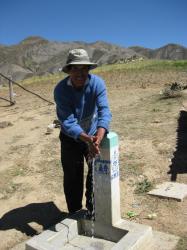My Nonprofit Reviews

Graham
Review for Quaker Bolivia Link, West Chester, PA, USA
I had the opportunity to visit QBL projects in Bolivia in 2004, 2006, and 2009 and have been impressed with how far US funds can go in improving the lot of Bolivians in rural communities (almost all are in the high Altiplano within 100 miles of La Paz) . Having grown up speaking both Spanish and English, I have been able to interact directly with the communities receiving QBL funding. Following are brief comments about some of the projects I visited. I visited Chua Cocani, a community not far from Lake Titicaca, in 2006 where the community had just installed faucets outside each home with potable water coming from springs to water tanks with gravity feed to the community. We walked by a home that had been abandoned in the past few years for lack of water. When I visited Colquencha in 2006, women in the community demonstrated that they had successfully implemented several QBL funded greenhouses to grow a variety of vegetables -- key to sound nutrition (there is frost at these high altitudes over 200 days per year). Colquencha was seeking support for bringing potable water to the community. When we visited Colquencha in 2009 they had just implemented the potable water project with QBL funding and with municipal funding for a pump. Both the Colquencha greenhouse and potable water projects were clearly benefiting the community. QBL funded a chicken project and a potable water project in Sacasaca. The chicken project was moderately successful with families raising chickens for their meat and eggs; however, some families opted out of raising chicks as chick mortality is high in the cold of the Altiplano. Prior to the implementation of the potable water project in Sacasaca there had been infant deaths from diarrhea but no such deaths since the implementation of the QBL funded project. Where potable water systems have been implemented, the migration out of the communities has decreased -- with an indirect benefit that property values in the communities have increased. In 2006 we visited a QBL funded dairy cow project at Hucuri Milluni with each participating family receiving one dairy cow. Teofila Huanca was a new proud owner of a dairy cow and was most anxious for me to take her photo with the cow. Holstein and Guernsey cows can not survive at the high altitudes and mixed breeds have been developed that have a considerable higher yield than the native dairy cows but not as high as the Holstein and Guernsey cows that can not survive at these high altitudes. In 2009 we were told that this dairy cow project continues to be successful. In talking to representatives of other NGO's I was told that the QBL Bolivian staff is recognized quite favorably for carrying out the funded projects in concert with the communities. I found that the communities nearly always praise the QBL Bolivian staff as being truly helpful in coordinating the implementation of projects.
More Feedback
I've personally experienced the results of this organization in...
Also see above. I have found that the greenhouse projects are allowing communities to eat a better balanced diet and to sell their excess production in local markets. Potable water projects are allowing communities to receive potable water for the first time and reduce the manual effort of carting water into communities -- this is allowing young girls to attend school to a greater extent.
If I had to make changes to this organization, I would...
seek more funding for the types of projects QBL has been funding. Bolivia is the poorest country in South America and poverty is greatest in the rural Altiplano (High plateau). These types of projects stem the migration to the large urban areas where there is much crowding and not very good employment opportunities. It might be useful to focus on a smaller geographical area for the projects for optimal utilization of the QBL Bolivian staff
Will you volunteer or donate to this organization beyond what is required of board members?
Definitely
How much of an impact do you think this organization has?
Life-changing
Will you tell others about this organization?
Definitely
How did you learn about this organization?
I read about Quaker Study Tours in a Quaker publication which led me to my first visit to Bolivia in 2004
What is this organization's top short-term priority?
Getting a sustained level of funding to carry out the types of projects that have been funded over the past 15 years
When was your last experience with this nonprofit?
2011




